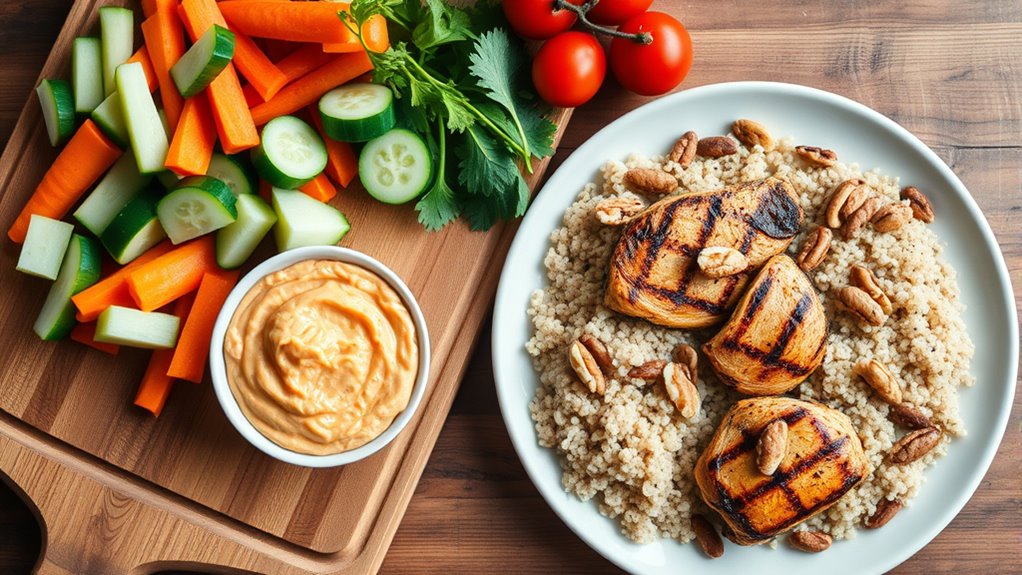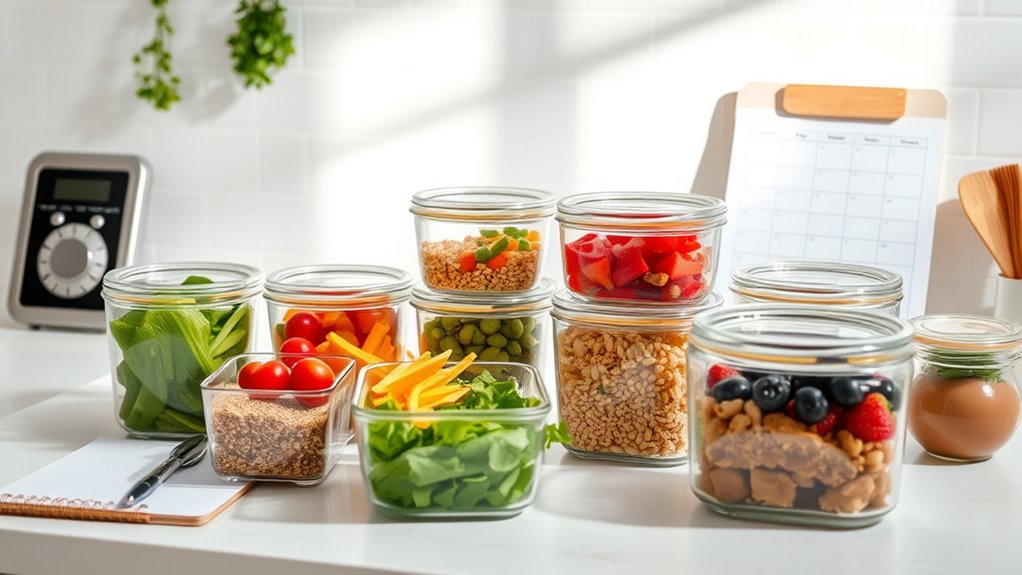Meal planning is based on understanding your body’s nutritional needs, balancing macronutrients like carbs, proteins, and fats, and controlling portion sizes to avoid overeating. Timing your meals consistently helps maintain energy and supports your metabolism. Creating habits around shopping, prep, and flexible routines makes sticking to healthy choices easier. Using apps can simplify tracking and variety keeps boredom at bay. Keep exploring, and you’ll uncover how these techniques come together for sustainable, balanced eating habits.
Key Takeaways
- Balanced meal planning ensures proper intake of macronutrients and micronutrients for optimal health and energy.
- Regular meal timing stabilizes blood sugar levels, reducing cravings and preventing overeating.
- Portion control helps manage calorie intake, supporting weight management and nutritional goals.
- Using technology like apps streamlines meal prep, tracking, and recipe variety for sustainable habits.
- Planning ahead and maintaining flexibility promotes long-term adherence and adaptability to changing tastes or schedules.
Understanding Nutritional Needs and Balancing Macronutrients

To create a balanced meal plan, you need to understand your body’s nutritional needs and how to properly combine macronutrients. Knowing the importance of micronutrients helps you ensure your diet supports overall health, energy, and immune function. Balancing macronutrients involves managing caloric distribution among carbohydrates, proteins, and fats to meet your daily energy requirements. Each macronutrient plays a crucial role: carbs provide quick energy, proteins support muscle repair, and fats sustain long-term fuel. By focusing on proper caloric distribution, you avoid overeating or undernourishing your body. Incorporating diverse nutrient sources ensures you’re getting essential vitamins and minerals, emphasizing that a well-rounded diet fuels your body efficiently and promotes well-being. Understanding the significance of contrast ratio can help you optimize your meal presentation and ensure your food looks as appealing as it is nutritious. This foundation is key to effective meal planning.
The Role of Portion Control and Serving Sizes

Balancing your macronutrients is essential, but managing portion sizes guarantees you don’t consume too many or too few calories. Portion awareness helps you stay on track with your goals. To master serving sizes, consider these tips:
- Use measuring cups or a food scale to portion out your meals accurately.
- Familiarize yourself with standard serving sizes, like a fist for carbs or a palm for protein.
- Read nutrition labels carefully to understand the actual serving size and calorie count.
- Employ portion control techniques to better manage your intake and achieve your nutritional goals.
How Meal Timing Impacts Your Energy and Metabolism

When you eat your meals at regular intervals, your energy levels stay stable, and your metabolism functions more efficiently. Meal timing influences your metabolic rate, helping your body burn calories more effectively throughout the day. Eating consistently prevents large fluctuations in blood sugar, which can cause fatigue and cravings. Skipping meals or eating erratically may slow down your metabolic rate, making it harder to lose weight or maintain energy. Conversely, regular meal timing helps your body optimize digestion and energy use. By establishing a routine, you support your body’s natural rhythms, ensuring your metabolism stays active and responsive. Proper meal timing isn’t just about what you eat but when you eat, playing a vital role in sustaining energy and promoting overall metabolic health.
The Psychology of Food Choices and Habit Formation

Have you ever wondered why you reach for certain foods more often than others? Your food choices are heavily influenced by your psychology and habits. Emotional eating, for example, often drives cravings during stressful times. To better understand this, consider these key points:
- Emotional triggers can prompt you to seek comfort foods, reinforcing habits over time.
- Food cravings are often linked to specific cues, like seeing or smelling favorite snacks.
- Habit formation happens when you repeatedly choose certain foods, making them your default choices.
- Recognizing relationship dynamics that influence your emotional well-being can help you develop healthier food habits.
Simplifying Grocery Shopping With Meal Planning

Meal planning transforms grocery shopping from a chaotic chore into a streamlined process. When you plan your meals in advance, you can create a focused grocery list that includes only what you need. This reduces impulse buys and saves time at the store. Incorporating meal prep into your routine makes shopping even easier—by knowing exactly what ingredients to buy, you avoid multiple trips or forgotten items. A well-organized grocery list based on your meal plan helps you stick to your budget and prevents unnecessary purchases. Plus, with a clear plan, you can shop more efficiently, moving through aisles faster and avoiding overwhelm. Ultimately, meal planning turns grocery shopping into a simple, purposeful task that supports your overall meal prep strategy. Effective planning also enhances your ability to maintain healthy eating habits and manage family nutrition needs.
The Importance of Variety and Food Diversity

Including a variety of foods in your meals helps balance essential nutrients and keeps your diet interesting. It also prevents boredom from eating the same foods repeatedly and promotes better gut health. By diversifying your choices, you support your overall well-being and enjoy more flavorful meals. Incorporating different food groups can also enhance your intake of vitamins and minerals, leading to improved health outcomes.
Nutrient Balance Enhancement
Why is incorporating a variety of foods essential for achieving balanced nutrition? It guarantees you get a broad spectrum of micronutrient variety, which supports overall health and prevents deficiencies. Additionally, food diversity helps you optimize meal timing by spreading nutrients evenly throughout the day, boosting absorption and energy levels. To enhance nutrient balance, consider these strategies:
- Incorporate different food groups daily to cover essential vitamins and minerals.
- Rotate protein sources and include colorful fruits and vegetables for micronutrient variety.
- Space out meals to improve nutrient absorption and maintain steady energy levels.
Prevents Dietary Monotony
Have you ever felt bored with the same meals day after day? Variety keeps your diet exciting and prevents dietary monotony. By mixing different flavor combinations, you introduce new tastes that make eating more enjoyable. Incorporating colorful fruits, vegetables, and proteins not only boosts nutrients but also enhances meal presentation, making your plates visually appealing. When your meals look inviting, you’re more motivated to stick with healthy options. Changing up ingredients and seasoning styles prevents your palate from becoming accustomed to the same flavors, keeping your interest piqued. This diversity encourages you to try new foods and maintains your enthusiasm for meal planning. Additionally, exploring different cultural decor themes and techniques can inspire creative presentation ideas that make meals feel special. Ultimately, a varied diet supports long-term healthy habits, making nutrition both satisfying and sustainable.
Supports Gut Health
A varied diet not only keeps your meals interesting but also plays an essential role in supporting your gut health. Incorporating different foods boosts fermentation health and enhances probiotic benefits, promoting a balanced microbiome. To achieve this, focus on:
- Eating a mix of fruits, vegetables, and whole grains to diversify your gut bacteria.
- Including fermented foods like yogurt, sauerkraut, and kimchi for natural probiotics.
- Avoiding over-reliance on processed foods, which can harm fermentation health and reduce probiotic effectiveness.
Behavioral Strategies for Staying Consistent

Staying consistent with meal planning can be challenging, but implementing effective behavioral strategies makes it achievable. One key approach is practicing mindful eating, which helps you recognize emotional cues that influence your food choices. When you pay attention to hunger and fullness signals, you’re less likely to eat out of boredom or stress. Setting specific, realistic goals keeps you focused and motivated, while establishing routines makes meal prep feel automatic. Accountability partners or journaling can reinforce your commitment, making setbacks easier to handle. Remember, awareness of emotional cues helps you differentiate between physical hunger and emotional cravings. Engaging in behavioral strategies that support your goals can make a significant difference. By staying attentive to these signals and sticking to your plan, you build habits that support long-term consistency and healthier eating patterns.
Using Technology and Apps to Optimize Planning

Using technology and apps can make meal planning more efficient and collaborative. You can explore features like customizable tools, recipe databases, and shopping list generators to save time. Plus, syncing and sharing options allow you to coordinate plans easily with family or friends. Incorporating user experience (UX) optimization principles into app selection can also enhance ease of use and satisfaction.
App Features & Tools
Ever wondered how technology can make meal planning easier and more efficient? App features and tools are designed to streamline your process. Here’s how:
- Calorie counting: Many apps automatically track calories based on food entries, helping you stay within your goals.
- Food labeling: Apps use detailed food labeling to provide accurate nutritional info, making meal choices easier.
- Recipe databases: Access thousands of recipes, save favorites, and generate shopping lists with a few taps.
These tools simplify tracking your intake and understanding food labels, so you can plan meals confidently. By leveraging app features like automatic calorie counting and all-encompassing food labeling, you optimize your meal planning for better health and convenience.
Syncing & Sharing Options
Harnessing syncing and sharing options in your meal planning apps can considerably boost your efficiency. Digital sharing allows you to easily distribute your meal plans with family or roommates, ensuring everyone stays on the same page. Synchronization features keep your data updated across multiple devices in real time, so you won’t lose track of your grocery list or meal schedule. With these tools, you can collaborate seamlessly, making adjustments that everyone can see instantly. This reduces miscommunication and saves time spent on back-and-forth messaging. Plus, sharing options let you integrate your meal plans with other apps, like grocery shopping or calendar tools, creating a streamlined workflow. By leveraging these digital sharing and synchronization features, you optimize your meal planning process with minimal effort. Creative ways to utilize these tools can further enhance your meal prep and planning experience.
Adjusting Plans Based on Personal Goals and Feedback

When you receive feedback or track your progress, it’s essential to adjust your meal plan accordingly to stay aligned with your goals. Personalized feedback helps identify what’s working and what’s not, guiding your goal adjustment process. To make effective changes, consider these steps:
Adjust your meal plan based on progress and feedback to stay aligned with your goals.
- Review your recent progress to see if you’re meeting targets.
- Identify any patterns or challenges in your current plan.
- Modify portion sizes, food choices, or timing based on your feedback.
- Incorporate insights from skin hydration and other relevant factors to optimize your plan further.
Building Sustainable Meal Habits for Long-Term Success

Building sustainable meal habits is key to maintaining your progress over the long term. To do this, focus on consistent meal prep routines that make healthy choices easier. Planning ahead helps you avoid impulsive decisions and keeps your nutrition on track. Incorporate recipe variety to prevent boredom and promote a balanced diet; try new dishes regularly to keep things interesting. Establishing a flexible approach allows you to adapt your meal plan as your tastes evolve or your schedule changes. Celebrate small successes along the way to stay motivated. By making meal prep a regular habit and exploring diverse recipes, you create a sustainable routine that supports your long-term health goals and makes healthy eating an effortless part of your lifestyle. Additionally, choosing healthy beverage options such as no-sugar-added drinks and incorporating nutritious juices like aloe vera or pineapple juice can enhance your hydration and overall well-being.
Frequently Asked Questions
How Can I Personalize Meal Plans for Specific Health Conditions?
You can personalize meal plans for specific health conditions by focusing on nutritional customization tailored to your needs. Consult with healthcare professionals to contemplate medical considerations like allergies, diabetes, or hypertension. Incorporate nutrient-dense foods that support your condition, and adjust portion sizes and ingredients accordingly. Tracking your symptoms and progress helps refine your plan, ensuring it’s effective and sustainable while addressing your unique health requirements.
What Are Quick Tips for Meal Prep on Busy Weekdays?
To make weekday meal prep quick, focus on snack prep and batch cooking. Spend a little time on weekends prepping snacks like cut veggies, nuts, or yogurt. Batch cook staples such as grains, proteins, and roasted veggies, then store them in containers. This way, you can quickly assemble meals or grab snacks, saving time during busy mornings or evenings. It’s efficient and keeps you on track with your health goals.
How Do I Handle Food Allergies Within Meal Planning?
Did you know that nearly 15 million Americans have food allergies? To handle allergy management, start by carefully reading labels and avoiding known allergens. Use ingredient substitutions to create safe, tasty meals that suit your needs. Planning ahead helps you prevent cross-contamination and guarantees you stick to allergen-free options, making mealtime safer and more enjoyable for you. Always keep emergency supplies handy just in case.
Can Meal Planning Aid in Weight Loss or Muscle Gain?
Meal planning can definitely help you with weight loss or muscle gain. You control portion sizes and focus on nutrient timing, making sure you get the right nutrients at ideal times. Planning ahead keeps you accountable, prevents overeating, and ensures balanced meals. By tailoring your plan to your goals, you maximize results and stay consistent, making it easier to achieve your desired weight or muscle-building progress.
What Are Budget-Friendly Strategies for Healthy Meal Planning?
To plan healthy meals on a budget, start with cost-saving tips like buying in bulk and choosing store brands. Incorporate seasonal shopping, which offers fresher, cheaper produce. Plan your meals around sales and versatile ingredients to minimize waste. Prepare meals at home instead of dining out, and make a shopping list to stay focused. These strategies help you save money while maintaining nutritious, balanced meals.
Conclusion
Think of meal planning as tending a garden—you nurture it daily, adjusting your tools and habits as needed. By understanding your nutritional landscape, controlling portions, and using technology, you set the stage for a thriving, healthy harvest. Stay consistent, adapt to your goals, and watch your habits grow strong over time. With patience and care, you’ll cultivate a sustainable routine that blossoms into long-term wellness—your personal garden of health.








